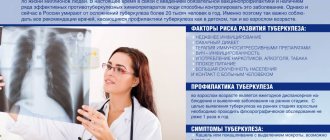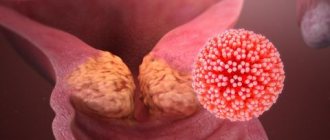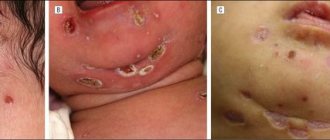“New” chlamydial infection
O. V. Zaitseva, Candidate of Medical Sciences M. Yu. Shcherbakova, Doctor of Medical Sciences, G. A. Samsygina, Doctor of Medical Sciences, Professor
RGMU, Moscow
Chlamydial infection plays a significant role in the structure of human infectious pathology. Every year, about 90 million new cases of chlamydial infection are registered in the world, including about 5 million in the USA, and 10 million in the Western European region [6]. However, research in recent years suggests that in fact the prevalence of chlamydia is much higher and we are talking not only about undiagnosed, atypical forms of the disease - scientists have proven the role of chlamydial infection in the development of somatic diseases such as bronchial asthma and atherosclerosis.
The main directions for diagnosing chlamydial infection are the determination of the pathogen itself or its antigens (direct methods) and the detection of anti-chlamydial antibodies (indirect methods). For direct detection of the pathogen, a cultural method (“gold standard”) and cytological analysis are used; for antigen detection, direct immunofluorescent analysis (DIF), enzyme-linked immunosorbent assay (ELISA) and hybridization methods—polymerase chain reaction (PCR) are used. Direct methods are widely used to diagnose acute genital infections, sexually transmitted diseases (STDs), and eye diseases. However, in chronic infections, especially when the pathogen persists, as well as in diseases with difficult-to-reach localization, the likelihood of identifying the pathogen or antigen, even when using modern highly sensitive methods, is low, and false negative results often occur. In this case, indirect research methods are useful. Of the serological tests, immunofluorescence, indirect hemagglutination test (IHA), and enzyme-linked immunosorbent assay (ELISA) are used - the most sensitive and highly specific test [7, 9].
When carrying out serological diagnostic methods, it is necessary to take into account that the diagnostic level of total antibody titers is achieved only after one to two weeks from the onset of infection and persists for more than a month. During reinfection or reactivation (with persistence of the pathogen), an abrupt rise in total antibody titers occurs, mainly due to IgG. In chronic infection, total antibodies remain at a constant level for a long time. Thus, the level of total antibodies cannot reliably indicate the stage of the infectious process, but is a good screening method for identifying infection.
Parallel determination of IgM, IgG, IgA allows not only to determine the presence of chlamydial infection, but also to clarify the phase of the disease (acute primary, chronic, reinfection/reactivation and residual serology). In the acute phase of the disease, on the fifth to seventh day of the onset of acute infection, IgM class antibodies are detected, a week later IgA appears, and only by the end of the second or third week of the disease can IgG class antibodies be detected. The progression of the disease, the transition from the acute to the chronic stage, is always characterized by a fairly high IgA titer, which persists for a long time, while the IgM titer quickly decreases. The chronic course of the disease is characterized by the presence of antibodies of the IgG and IgA classes that persist for a long time, and low titers of these antibodies may indicate persistent pathogens. During reinfection or reactivation (with persistence of the pathogen), an abrupt rise in IgG titers occurs (booster effect), which in untreated patients remains at an unchanged level for a long time. Low titers of IgG may indicate the initial stage of infection or indicate a long-standing infection (“serological scars”).
For timely diagnosis and when developing effective treatment regimens for chlamydial infection, it is important to take into account that the production of antibodies to chlamydial antigens and phagocytosis of chlamydial macrophages occur only at the ET stage, when chlamydial cells are in the intercellular space and are available for contact with antibodies, lymphocytes and macrophages. At the RT stage, immune reactions of the host organism (cellular and humoral) are impossible, which creates certain difficulties for the timely diagnosis of the disease, and chlamydia itself is protected, not only from various influences from the host organism, but also from most antibacterial drugs that cannot penetrate into the cell.
Data on the clinical picture of various types of chlamydia are quite diverse. The most widespread and well-studied diseases are those caused by Chlamydia trachomatis (Ch. tr.) and, as a rule, occur as urogenital chlamydia. Ch. tr. - the most common cause of sexually transmitted diseases (STDs). Children born to infected women have a fairly high risk of developing pneumonia and conjunctivitis in the first months of life. In individuals with the HLA-B27 Ch. tr. may cause Reiter's disease.
Chlamydophila psittaci mainly affects birds. In humans, this intracellular pathogen can cause respiratory tract infections (psittacosis, psittacosis), usually manifesting as atypical pneumonia.
Chlamydophila pecorum is a zoonosis and does not cause disease in humans.
The greatest interest among researchers is currently caused by infections caused by Chlamydophila pneumoniae (Ch. pn.). Until recently Ch. pn. was known as the TWAR strain, and only in 1989 it was isolated as a separate species of chlamydia.
Data regarding the prevalence of this infection are quite contradictory. There are indications that the frequency of seropositive cases in the adult population reaches 70% (residual immunoglobulins of class G are more often detected) [6]. However, studies in recent years, which used modern highly specific serological methods, indicate that antibodies to Ch. pn. are found only in 17–40% of cases. The higher incidence of seropositive cases in population studies in previous years is explained by the presence of cross serological reactions between Ch. pn. and Ch. tr.
Ch. pn. is one of the causes of respiratory pathology - up to 15–25% of all cases. The most common infection caused by Ch. pn., occurs in children and young people and occurs in the form of pneumonia (so-called atypical pneumonia), acute and chronic bronchitis, pharyngitis, sinusitis, otitis. Diseases, as a rule, are asymptomatic. Possible reinfection with Ch. pn., in this case the course of the disease is more severe than with primary infection [1, 6, 11].
A new page in the study of the role of Ch. pn. was discovered in the mid-90s, when the widespread use of serological diagnostic methods made it possible to clarify the role of chlamydial infection in such somatic diseases as bronchial asthma, atherosclerosis, etc. Over the course of several years, truly revolutionary discoveries were made, representing a new perspective on the pathogenesis of these diseases.
Determining the role of infection in patients with bronchial asthma (BA) has long been an urgent problem [3, 4, 10]. It is well known that an infectious process can be a trigger for an attack of bronchospasm, i.e., a provoking factor, and the pathogen can become a causally significant allergen. However, the impact of infection caused by Ch. pn., the course of allergic inflammation of the bronchi in patients with asthma is more multifaceted. Numerous data presented in foreign literature in recent years indicate that chlamydial infection actively affects the immunological reactions of a patient with asthma, changing the course of the underlying disease. In addition, patients with atopic asthma are predisposed to persistent intracellular infections. In patients with atopic bronchial asthma infected with Ch. pn., on the one hand, there is a genetically determined hyperproduction of IgE and a number of cytokines (IL-3, IL-4, IL-5, IL-6, TNF-α, etc.), which support allergic inflammation, on the other hand, low levels of INF-γ and hyperproduction of IL-5, characteristic of this group of patients, facilitate infection and contribute to the persistence of the pathogen.
According to various publications, serologically confirmed chlamydial respiratory infection is associated with both the development of acute attacks of asthma and the chronic, relapsing course of asthma, which confirms the role of this intracellular pathogen in the development of airway hyperresponsiveness [3]. It has been shown that in children with asthma under five years of age infected with Ch. pn., bronchospasm occurs significantly more often than in uninfected patients.
Numerous studies have shown the effectiveness of anti-chlamydial therapy in patients with asthma infected with Ch. pn. Multicenter international studies conducted among patients 13–65 years old suffering from asthma showed that a significant improvement in the course of the disease and a decrease in steroid dependence were observed after a three-month course of antibacterial therapy with macrolide antibiotics.
Studies conducted in the UK and the USA revealed a statistically significant increase in the incidence of steroid-dependent forms of bronchial asthma in patients infected with Ch. pn., compared to uninfected ones. After specific antibacterial therapy, there was an improvement in the course of the disease and a decrease in steroid dependence.
Thus, timely eradication of atypical pathogens in patients with bronchial asthma in combination with basic anti-inflammatory and, if necessary, bronchodilator therapy can help improve the course and prognosis of the disease.
Interest in Ch. pn. as a possible risk factor for the development of atherosclerotic process arose after the publication of the results of a study that revealed a high frequency of detection of elevated titers of antibodies to this microorganism in patients with coronary heart disease. During the examination, high titers of IgG and/or IgA were detected in 68% of patients with myocardial infarction, in 50% of patients with coronary heart disease, and only in 17% of people in the control group.
However, the question of the primacy of infection and the clinical manifestation of the atherosclerotic process still remains open. Ch. pn. has the ability to form colonies in the endothelial wall, thereby damaging the vascular wall and provoking an immune reaction with the release of cytokines, the synthesis of prothrombotic factors, in particular tissue factor, which can lead to the destabilization of an existing plaque and/or the initiation of atherosclerotic damage. In addition, Ch. pn. can be captured by macrophages and transported through the bloodstream to existing plaques, causing their transformation into foam cells or increasing the inflammatory response.
Further studies confirmed the existence of an association between Ch. pn. and ischemic (coronary) heart disease, and similar results were obtained in different patient populations [13]. According to our data, the frequency of detection of increased titers of antibodies to Ch. pn. in persons who have suffered a myocardial infarction, reaches 55-70%, while in healthy persons there are increased titers of antibodies to Ch. pn. were detected only in 15-20% of cases (p < 0.05) [12]. Analysis of the profile of immunoglobulins and their relationship with changes in the lipid spectrum made it possible to consider chronic chlamydial infection as a risk factor for the development of atherosclerosis, with the highest value of Ch. pn. has angina pectoris and myocardial infarction.
Ch. pn. was found in atherosclerotic plaques of various locations (coronary, carotid arteries, thoracic and abdominal aorta). Detection frequency Ch. pn. in plaques with signs of thrombosis was significantly higher than in plaques without thrombosis (56.7 and 16.7%, respectively). To detect the microorganism, various techniques were used - polymerase chain reaction, immunocytochemical, electron microscopy. It has been proven that in unchanged vessels Ch. pn. was not determined.
Cell culture experiments showed that macrophages, endothelial and smooth muscle cells in vitro support the growth of Ch. pn., which may confirm the role of this microorganism in the pathogenesis of atherosclerosis.
Study of possible relationships Ch. pn. and atherosclerosis has been continued in animals. Introduction of culture Ch. pn. rabbits showed the possibility of transformation of macrophages into foam cells, the development of proliferation of smooth muscle cells and aortitis was revealed, which indirectly indicates the pathological role of this microorganism in the occurrence of atherosclerosis. The use of azithromycin in infected animals helps prevent changes in the vascular intima. Similar data were obtained during experiments on laboratory mice.
Some researchers show a high frequency of serological detection of Ch. pn. for cerebral disorders - cerebral stroke and/or transient cerebral ischemia.
Data obtained by various researchers on the role of infection in the development of atherosclerosis confirm the importance of Ch. pn. as the main infectious agent, contributing not only to the progression of existing signs of the disease, but also to the initiation of the pathological process itself.
The possible presence of an infectious factor in atherogenesis served as the basis for including antibacterial drugs in the treatment of patients with atherosclerosis. Currently, data have already been accumulated indicating the effectiveness of macrolides in patients with clinical manifestations of atherosclerosis. Inclusion of azithromycin in a therapeutic complex intended for patients with high titers of antibodies to Ch. pn., significantly reduced the incidence of adverse cardiovascular events - the risk of their development in treated patients with high antibody titers was the same as in the group of patients without antibodies. A multicenter, double-blind, randomized, prospective, placebo-controlled study that assessed the therapeutic efficacy of roxithromycin for unstable angina or non-Q-wave myocardial infarction in 212 patients showed a significant reduction in the incidence (recurrent myocardial infarction, severe recurrent ischemia) with the use of the antibiotic. It is assumed that the mechanism of action of roxithromycin is based not only on the direct antichlamydial effect of this drug, which helps suppress inflammatory activity in plaques, but also on its immunomodulatory, antioxidant and antithrombotic activity.
A generalization of accumulated information about the relationship between infection and coronary heart disease leads some researchers to the conclusion about the undeniable role of Ch. pn. in atherogenesis. The authors provide the following arguments in favor of the chlamydial genesis of atherosclerosis.
1. Correlation of coronary heart disease and atherosclerosis with the detection of antibodies to Ch. pn.
2. High detection rate of Ch. pn. in atheromatous plaques using various methods (PCR, immunohistological, electron microscopic, cultural).
3. Results of an international study assessing the effectiveness of antibacterial therapy for chlamydial infection in patients with coronary heart disease.
4. The fact that the target cells of atherosclerotic lesions (endothelium, macrophages, smooth muscle cells) can be affected by Ch. pn. in in vitro experiments.
5. Successful experiments on laboratory animals.
The high incidence of atherosclerosis among men is explained by the androtropism of the infection (as in pneumococcal pneumonia, tuberculosis), and the trend towards a decrease in the incidence of atherosclerosis, observed since 1965, is due to the widespread introduction of recognized anti-chlamydial drugs - macrolides - into clinical practice.
The position about the role of infection as a risk factor for the development of atherosclerosis, which has recently received more and more confirmation, has led to the assumption that “perhaps the day will come when a patient after a myocardial infarction will undergo a course of treatment that includes not only aspirin, β-blockers, an angiotensin-converting enzyme inhibitor , statins, antioxidants, but also an antibiotic.”
So, the study of chlamydial infection at the present stage has made it possible to take a completely new look at this fairly common pathogen and evaluate its role in the development and course of a wide range of not only infectious, but also somatic diseases. Early diagnosis of various types of chlamydia and timely comprehensive treatment, including antibacterial and immunocorrective drugs, can certainly improve the prognosis of the disease.
Literature
1. Current microbiological and clinical problems of chlamydial infections. Sat. works ed. A. A. Shatkina, J. Orfila. M., 1990. 2. Beatty V.L., Morrison R.P., Byrne D.I. Persistence of chlamydia: from cell cultures to the pathogenesis of chlamydial infection // Sexually transmitted diseases. 1996, No. 6. 3. Bronchial asthma. Global strategy. Joint report of the National Heart, Lung, and Blood Institute and the World Health Organization. Issue No. 95-3659, Jan. 1995. 4. Bronchial asthma /Ed. A. G. Chuchalina. In 2 volumes. M., 1997. 5. Ward M. E. Modern data on the immunology of chlamydial infection // Sexually transmitted diseases. 1996. No. 6. P. 3-6. 6. Intracellular pathogens (microbiology, diagnosis, treatment). Information letter for doctors. M., 1998, p. 12. 7. Delectorsky V.V., Yashkova G.N. et al. Familial chlamydia. A manual for doctors. M., 1996, p. 22. 8. Zaitseva O. V., Levshin I. B., Lavrentiev A. V., Zaitseva S. V., Skirda T. A., Martynova V. R., Kolkova N. I., Samsygina G. A. Frequency of occurrence and features of the course of bronchial asthma in children associated with Chlamydia pneumoniae // Pediatrics. 1999. No. 1. P. 29-33. 9. Krotov S. A., Krotova S. A., Yuryev S. Yu. Chlamydia: epidemiology, characteristics of the pathogen, laboratory diagnostic methods, treatment. Toolkit. Koltsovo, 1997, p. 63. 10. National program “Bronchial asthma in children. Treatment strategy and prevention." M., 1997. 11. Samsygina G. A. Macrolide antibiotics for respiratory infections in children. Antibacterial therapy in pediatrics: Sat. ref. conf. M., 1997. P. 4-16. 12. Samsygina G. A., Shcherbakova M. Yu., Murashko E. V., Chulchina T. N., Martynova V. R., Levshin I. B. Chlamydia pneumoniae infection as a probable risk factor for the development of atherosclerosis // International Journal medical practice. 1998. No. 2. P. 133-136. 13. Sumarokov A. B., Pankratova V. N. Study of titers of specific antibodies IgG-, IgA- and IgM-antibodies to the microorganism Chlamydia pneumoniae in patients with initial atherosclerosis of the carotid arteries // Practitioner. 1999. No. 15. P. 10-12. 14. Shatkin A. A., Popov V. L. et al. Persistent chlamydial infection in cell culture. West. USSR Academy of Medical Sciences. 1985. No. 3. P. 51-54. 15. Eidelshtein I. A. Fundamental changes in the classification of chlamydia and related microorganisms of the order Chlamydiales // Clinical microbiology and antimicrobial chemotherapy. No. 1. T. 1. 1999. P. 5-11.
A little microbiology
Chlamydia are obligate intracellular pathogens, meaning they can only reproduce intracellularly. Chlamydia is close in structure to classical bacteria, but does not possess the metabolic mechanisms necessary for independent reproduction. The bacteria-like characteristics of chlamydia (DNA and RNA content, the presence of a cell wall, preservation of the morphological essence throughout the life cycle, division of vegetative forms, the nature of enzymatic activity, sensitivity to a number of antibiotics, the presence of a common genus-specific antigen) made it possible to classify them as bacteria and assign them to the Chlamydiaceae family , genus Chlamydia. Within this genus, 4 types of chlamydia were distinguished: Chlamydia trachomatis (Ch. tr.), Chlamydia pneumoniae (Ch. pn.), Chlamydia psittaci (Ch. ps.), Chlamydia pecorum (Ch. pec.) [9]. Further study of the characteristics of life and metabolism of chlamydia gave Everett K. the basis to propose a new classification, according to which the Chlamidiaceae family includes two genera: Chlamydia and Chlamydophila. The causative agents of human infections are Chlamydia trachomatis (genus Chlamydia), Chlamydophila pneumoniae and Chlamydophila psittaci (genus Chlamydophila).
Despite the fact that chlamydia possess all the cellular mechanisms for the synthesis of DNA, RNA and proteins, they depend on the host cell to supply them with nucleotides, amino acids, and enzymes for the synthesis of ATP. Chlamydia constantly competes with its host for vitamins, cofactors, nutrients and energy compounds [1, 9].
Chlamydia has a two-phase life cycle, the uniqueness of which is due to the presence of two different forms of existence of bacteria: elementary bodies (EB) - an infectious form that can penetrate cells and is adapted to extracellular survival due to low metabolic activity; reticular bodies (RT) are a vegetative, non-infectious, metabolically active form, capable of division and found only inside cells. In their development, chlamydia perform a kind of cycle: RTs originate from ETs, and also give rise to them (see figure). The life cycle of chlamydia can be divided into five main stages.
| Life cycle of chlamydia |
1. Infection: EBs adhere to the surface of target cells and are then captured by them to form vesicles. The process of adhesion to the host cell is one of the most complex and critical moments; lipopolysaccharides and proteins of the outer membrane of the chlamydial cell, membrane (receptor) proteins of the host cell, as well as electrostatic and hydrophilic-hydrophobic interactions take part in it.
2. Formation of RT: vesicles with ET move into the perinuclear space, form inclusions inside the cytoplasm, increase in size, turning into RT.
3. Division of RT with the formation of a large number of daughter bacteria.
4. Formation of ET: young RTs decrease in size (condense), turning into ETs. This occurs 20–30 hours after chlamydia enters the cell.
5. Dissemination of ETs: as the infectious process progresses, the cell wall of the host cell ruptures and newly formed infectious ETs are released.
The normal life cycle of chlamydia is usually 48–72 hours. However, under certain conditions, L-like transformation and persistence of chlamydia are possible [2]. Persistence implies long-term association of chlamydia with the host cell; chlamydial cells are in a viable state, but are not detected by culture. The term "persistent infection" refers to the absence of obvious growth of chlamydia, suggesting their existence in an altered state different from their typical intracellular morphological forms. In the persistent state, chlamydia growth is delayed, which correlates with a decrease in metabolic activity. In this case, growth and division stop, and differentiation in the ET is also delayed, which leads to a hidden (latent) state. Limited metabolic activity may also affect the biochemical and antigenic characteristics of a persistent microorganism that becomes undetectable by conventional diagnostic tests. However, the pathogen in the resting phase retains the ability to resume active growth and the process of reorganization into infectious forms [3, 9, 14].
Research in recent years has confirmed that deviations from the typical development cycle of chlamydia are largely dependent on changes in the external environment, such as an imbalance of essential nutrients (mainly amino acids), the presence of antimicrobial agents and some others. The study of immunologically induced persistence has shown that the precedent of persistence can be induced by many factors of the immune system: interferons, interleukins 4, 5, tumor necrosis factor-α, macrophages, etc. [6].
The synthesis of interferon γ (INF-γ) plays a key role in the interaction of chlamydia with the host immune system, which determines the course of the disease and influences the persistence of the microorganism. It has now been established that high levels of IFN-γ can completely inhibit the growth of chlamydia and, in addition, promote the lysis of infected cells with the release of non-viable forms of the pathogen, which underlies freedom from infection. At the same time, low levels of IFN-γ induce the development of morphologically abnormal intracellular forms, which leads to persistence of the pathogen [9].
The development, course and outcome of chlamydial infection are determined primarily by the state of the macroorganism, the characteristics of its immune reactions (including genetically determined ones), homeostasis indicators, the presence of concomitant pathology and many other factors, as well as the unique biological properties of the pathogen, its ability to persist for a long time, antigenic and immunological mimicry.
Note!
- The main directions of diagnosis of chlamydial infection are the determination of the pathogen itself or its antigens (direct methods), the detection of anti-chlamydial antibodies (indirect methods)
- When carrying out serological diagnostic methods, it is necessary to take into account that the diagnostic level of total antibody titers is achieved only 1-2 weeks from the onset of infection and persists for more than a month
- For timely diagnosis and when developing effective treatment regimens for chlamydial infection, it is important to take into account that the production of antibodies to chlamydial antigens and phagocytosis of chlamydial macrophages occur only at the ET stage
- Chlamydial infection actively affects the immunological reactions of a patient with asthma, changing the course of the underlying disease
- C. pn. was found in atherosclerotic plaques of various locations (coronary, carotid arteries, thoracic and abdominal aorta)
Life cycle of chlamydia
Features of the development of chlamydia can be considered using the example of an elementary body. There are no other similar bacteria in nature. The microorganism is born during the process of infection of the host cell by ET. This process is called phagocytosis. Typically, the infection attaches to the nonciliated epithelium of the genital organs of the small pelvis: the mucous membrane of the urethra, endometrium, and fallopian tubes.
The next life cycle of chlamydia after attachment is penetration into the host cell. The bacterium remains inside the cell in a cytoplasmic vacuole. Chlamydia requires cellular ATP for growth and development. The bacterium is protected from death by the vacuole shell. One cell can contain several future microorganisms at once.
The primary body turns into a reproductive body after only 8 hours in the cytoplasm of the cell. It is approximately 3 times more massive than the elementary body. Its main difference is its strong metabolic activity, that is, the bacterium can already divide and multiply. At this stage, chlamydia cannot produce energy on its own, so it feeds on ATP from the host cells. Reticular bodies cannot yet infect; they do not have the opportunity to survive without energy outside the cell.
It takes 8 hours to 24 hours for the bacteria to divide. Reproductive bodies can divide in only up to 12 cycles, with daughter microorganisms becoming smaller, denser and turning into an intermediate form, from which new elementary bodies are subsequently formed. A chlamydia colony completely fills the cell.
The colony is called a chlamydial inclusion and contains both reticular and primary bodies. If observed under a microscope, after three days the microcolony grows to the size of a leukocyte and can be seen. If you observe for another 72 hours, you can see how the colony destroys the cell membrane and hundreds of chlamydia emerge from it. Bacteria begin to infect the entire body. The bodies find new cells, and the life cycle repeats again. It takes 72 hours for the bacteria to complete its cycle. With insufficient nutrition or poor quality therapy, the reproduction process can last from several days to a couple of months.
All types of chlamydia have the same development cycle and similar chemical composition. Elementary and reticular bodies have a three-layer shell.
Chlamydia in the active phase should be treated with antibiotics. It is important to consult a doctor promptly when the first symptoms appear. Follow all doctor's recommendations and do not skip taking medications.
The presence of a cell membrane combines chlamydia with bacteria - this allows the use of antibiotics to treat chlamydia.
Tropism to the epithelium of certain organs (genitourinary organs, conjunctiva).
Having a unique life cycle.
Life cycle of chlamydia
Chlamydia exists in the body in 2 forms: elementary bodies (EB) - or extracellular and infectious bodies. Reticular bodies (RT) are the intracellular form of the pathogen. ETs penetrate into the epithelial cell and form a colony. RTs (inclusions), which, using the energy resources of the host cell, multiply, passing first into the so-called intermediate bodies, and then into new EBs, which emerge from the destroyed cell into the intercellular space and infect new cells. The entire development cycle lasts 48-72 hours and 200-1000 new ETs are formed in one development phase.
Important notes about the term chlamydia
Humans can be parasitized by 4 types of chlamydia:
1. Chlamydophila pneumoniae - transmitted by airborne droplets and causes respiratory infections;
2. Chlamydophila psittaci - transmitted from birds (often from domestic parrots and pigeons) causes the disease ornithosis - lung damage;
3. Chlamydophila pecorum - transmitted from mice, cattle - causes respiratory infections;
4. Chlamydia trachomatis - divided into the following antigenic serotypes: A,B,Ba,C - causes trachoma, D - K - cause conjunctivitis and urogenital infections, L1,L2,L3 - cause lymphogranuloma venereum.
We will consider chlamydia, which causes urogenital diseases.
ROUTES OF TRANSMISSION AND CONDITIONS OF INFECTION
The incubation period is from 2 weeks to 1 month. The main route of infection is vaginal, oral or anal sexual contact. Children can become infected when a fetus passes through the birth canal of a mother with chlamydia. Contact-household transmission is also possible (it has been established that chlamydia remains infective on household items, including cotton fabrics, for up to 2 days at a temperature of 18-19 degrees).
SYMPTOMS OF CHLAMYDIOSIS
The entire course of chlamydia in humans can be divided into the following stages: primary infection, recurrent course or persistence, self-healing, development of complications.
PRIMARY INFECTION
After an incubation (hidden) period, the duration of which depends on the amount of chlamydia that has entered the body and the state of the body’s local immune defense (on average from 7 to 20 days), the first clinical symptoms of the disease appear. Due to the fact that chlamydia affects only certain cells - the columnar epithelium - chlamydia is characterized by a favorite localization - i.e. colonization and reproduction of chlamydia in certain human organs. These are: the mucous membranes of the urethra, cervical canal, pharynx and conjunctiva of the eye, rectum.
In addition, in the first months of life, columnar epithelium is present in the bronchi of the newborn, subsequently being replaced by ciliated epithelium. Based on the above, the main manifestations of chlamydia during primary infection: Chlamydial urethritis in men: the most common and main form of manifestation of chlamydia in men. Infection of the urethra with chlamydia occurs during vaginal, oral and anal sexual intercourse with a patient with chlamydia. It manifests itself as scanty mucopurulent (milky) discharge, often detected only in the morning after massage of the urethra. There is practically no redness and swelling of the “urethral sponges”, there are no subjective disorders (pain, cramping). In most cases, there is mild itching in the urethral area. In women, the urethra is rarely affected. Chlamydial endocervicitis and (or) cervicitis in women: the most common and main form of manifestation of chlamydia in women. Infection of the cervical canal with chlamydia occurs during vaginal sexual contact with a patient with chlamydia (infection is also possible during oral sex - cunnilingus). It manifests itself as scanty mucopurulent discharge, which the sick woman does not notice. There are no subjective symptoms (pain). Chlamydial proctitis: an often underdiagnosed but common form of primary chlamydia. Infection occurs during anal and oro-anal sexual intercourse; in women, transmission from the genitals is possible in the presence of heavy discharge. There are no external signs. The diagnosis is made by rectomanoscopy and the detection of chlamydia in scrapings from the rectal mucosa. In rare cases, due to damage to the rectal mucosa, stool mixed with blood and painful sensations during bowel movements are noted. Chlamydial pharyngitis: also a commonly undiagnosed but common form of chlamydia. Infection occurs through oral-genital and oral-anal contact. Transmission through kissing has not been clearly proven. There is redness in the back of the throat and a sore feeling. Symptoms are not expressed and they are not given importance, both by the patient and often by the doctor. Chlamydial conjunctivitis: infection occurs when the infection is introduced from the genitals through the hands. The mechanism of conjunctivitis in Reiter's disease is not clear. There is lacrimation, redness of the mucous membrane of the conjunctiva of the eye, and less often the presence of mucopurulent discharge. The process is in most cases one-sided. Chlamydial balanoposthitis: most often occurs in the form of circinar balanitis (damage to the glans penis) with clearly defined lesions. Most common in Reiter's disease, involvement of the foreskin is extremely rare. In most cases there are no subjective symptoms.
ASYMPTOMIC COURSE (Persistence of chlamydia)
In some cases, chlamydia persists for a long time in the body in the form of isolated microcolonies on the mucous membranes - the so-called carriage. Clinical, instrumental and laboratory examination does not reveal any signs of organ damage - i.e. a person is clinically healthy; only when using high-precision laboratory diagnostic methods (PCR, culture) are chlamydia detected. This condition is associated with the suppression of the reproduction of chlamydia by the body's immune system; often such carriers are even safe from an epidemiological point of view (i.e., they do not infect sexual partners).
RECURRENT COURSE
If treatment is not started, in most cases the symptoms that arose during the period of primary infection disappear spontaneously and can recur under the influence of various factors. A temporary “truce” appears between the organism and the pathogen. Exacerbation of the disease is manifested by the appearance of symptoms as during primary infection, but in less pronounced and short-term forms. But this does not mean that the presence of chlamydia is harmless to the body. The most characteristic manifestations of the recurrent course of the disease are: chronic fatigue syndrome - associated with the effects of chlamydia activity products on the central nervous system (drowsiness, irritability, depression, fatigue). Due to the negative impact of chlamydia on normal microflora, their role in the occurrence of nonspecific balanoposthitis in men and in the development of bacterial vaginosis in women cannot be ruled out. Also noteworthy is the frequent combination of urogenital candidiasis and chlamydia.
COMPLICATIONS OF CHLAMYDIOSIS
However, in most cases, the recurrent course of the disease leads to the development of various complications. Reiter's disease , or urethro-oculo-synovial syndrome, the most dangerous complication of chlamydia, often leading to disability of the patient (deformation and contracture - "fusion" of the joints) - is characterized by a triad of symptoms: urethritis, conjunctivitis and arthritis. Also with the syndrome, various types of skin lesions and circinar balanoposthitis occur. The mechanism of development has not been fully established; opinions are mainly expressed about the autoimmune nature of the syndrome - the body begins to produce antibodies against its own epithelial cells. If previously Reiter's syndrome was observed only in men, recently cases of the disease have begun to be reported in women. Urethral stricture is a narrowing of the urethra due to cicatricial changes in the urethral mucosa, the only treatment for which is surgery, which does not always have a successful outcome. Orchiepididymitis - leading to a narrowing of the sperm ducts and death of Leydig cells, which leads to the cessation of spermatogenesis (sperm production) and, accordingly, to male infertility. Chronic prostatitis leads to the death of glandular tissue of the prostate gland, narrowing of the prostate ducts and, accordingly, a change in the quantity and quality of prostate secretion, which leads to immobilization and rapid death of sperm. There is also evidence that the synthesis of active testosterone occurs in the prostate gland - i.e. in the presence of chronic prostatitis, due to disruption of this process, the amount of testosterone in the body decreases, which leads to a decrease in potency (disappearance of libido). Pelvic inflammatory disease (PID) in women - chlamydial infection can penetrate the uterus, uterine appendages, fallopian tubes of a woman, causing an inflammatory process there - endometritis, salpingo-oophoritis, salpingitis; chlamydia often causes chronic abdominal pain syndrome in women. A distinctive feature of chlamydia is the formation of scars and adhesions in the fallopian tubes, which is the cause of ectopic pregnancy and tubal infertility.
CHLAMYDIOSIS AND PREGNANCY
In addition to the fact that the presence of chlamydia often leads to premature termination of pregnancy (miscarriages), infection of the fetus during childbirth poses a danger (up to 40%). The main forms of manifestation of chlamydia in newborns (congenital chlamydia): ophthalmochlamydia (20%) - conjunctivitis with inclusions, chlamydial pneumonia of newborns (20-25%), generalized form with damage to the lungs, heart, liver, gastrointestinal tract, encephalopathy with convulsions, apnea (respiratory arrest).
Chlamydial pneumonia of newborns - infection of a newborn with chlamydia during childbirth from a sick mother often leads to pneumonia (pneumonia) with an extremely severe course and high mortality.
FAMILY CHLAMYDIOSIS
It has been established that in families where parents are sick with urogenital chlamydia, up to 30% of children are also affected by this disease. Infection occurs through household means (through hygiene items) or through accidental introduction of infection into the eyes
LABORATORY DIAGNOSTICS
For the purpose of laboratory diagnostics, enzyme-linked immunosorbent assay (ELISA), direct immunofluorescence reaction (DIFR), cultural testing and polymerase chain reaction (PCR) are used. The best results are obtained by combining several diagnostic methods.
TREATMENT OF CHLAMYDIOSIS
Treatment should be prescribed taking into account the duration of the disease, the clinical picture, the location of the lesion, and the presence or absence of complications. Sexual partners are subject to mandatory examination and, if necessary, treatment. During the period of treatment and clinical observation, sexual activity is not recommended, or a condom is used.
Grigoriev D.V. Ch. doctor at MC “Healthy Generation”








